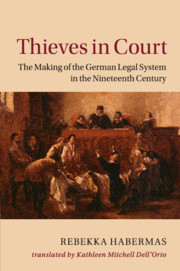Book contents
- Frontmatter
- Dedication
- Contents
- Acknowledgments
- Introduction: Questions Regarding Thieves, Reformers, Jurists, and Others
- PART I WHAT IS THEFT: QUESTIONS REGARDING THIEVES AND JURISTS – QUESTIONS REGARDING HONOR AND PROPERTY
- 1 Who Are the Thieves and Who Are the Victims?
- 2 How Does a Person End Up in Court – Why Does Something Go on the Record?
- 3 The Theft Happens – from Act to Crime
- PART II HOW LAW IS MADE: EVIDENCE PRODUCTION
- PART III IN THE COURTROOM, OR WHAT IS LAW?
- Conclusion: The Making of the Modern Legal System – Thieves and Property
- Relevant Laws
- Bibliography
- Index
1 - Who Are the Thieves and Who Are the Victims?
from PART I - WHAT IS THEFT: QUESTIONS REGARDING THIEVES AND JURISTS – QUESTIONS REGARDING HONOR AND PROPERTY
Published online by Cambridge University Press: 18 November 2016
- Frontmatter
- Dedication
- Contents
- Acknowledgments
- Introduction: Questions Regarding Thieves, Reformers, Jurists, and Others
- PART I WHAT IS THEFT: QUESTIONS REGARDING THIEVES AND JURISTS – QUESTIONS REGARDING HONOR AND PROPERTY
- 1 Who Are the Thieves and Who Are the Victims?
- 2 How Does a Person End Up in Court – Why Does Something Go on the Record?
- 3 The Theft Happens – from Act to Crime
- PART II HOW LAW IS MADE: EVIDENCE PRODUCTION
- PART III IN THE COURTROOM, OR WHAT IS LAW?
- Conclusion: The Making of the Modern Legal System – Thieves and Property
- Relevant Laws
- Bibliography
- Index
Summary
LIFE AND SURVIVAL “ON THE MARGINS”
Who were the thieves, where did they come from, and what social and economic changes did they have to contend with in the mid-nineteenth century? Let's look at Anton Zimmermann again: Starting with the simplest data, he was a man and still quite young – thus pretty typical, and not only for thieves in the Marburg region. If the hand-written record books of the Marburg High Court District are consulted, the data from more than six thousand defendants indicate that crime in general was an overwhelmingly male phenomenon. Likewise, for property crimes, we are dealing in most cases with men, although there the proportion of women, at a substantial 20 percent both in Electoral Hesse and elsewhere, was somewhat higher than for crime overall.
Most property crimes were thus committed by men, and in fact by fairly young men; the thieves were as a rule between twenty and thirty years old. In this respect, too, the twenty-two-year-old Zimmermann proves to be typical. This age is associated with a particular social status, that of the single man. None of the scant twenty-five property crime records examined more closely report a man with children, much less a married man. That also means that these men had not yet had an opportunity to obtain the financial basis for establishing a household. The situation looks the same for the few recorded female thieves; they were for the most part between fifteen and thirty years old and the majority were single.
Anton Zimmermann's occupation – he was a day laborer – also proves to be typical, not only for thieves, but for Electoral Hessian male offenders in general. From the standpoint of overall crime, the majority of all offenders were day laborers or artisans; less often they were plowmen or messengers. Educated middle-class citizens were almost completely absent. These findings tend to be confirmed for the subgroup of thieves. Crime in general and theft in particular was a lower class phenomenon in the mid-nineteenth century, in contrast to the eighteenth century. Poverty seems to have been a characteristic of thieves – the dry figures reveal that much. That may not be very surprising.
- Type
- Chapter
- Information
- Thieves in CourtThe Making of the German Legal System in the Nineteenth Century, pp. 19 - 54Publisher: Cambridge University PressPrint publication year: 2016



